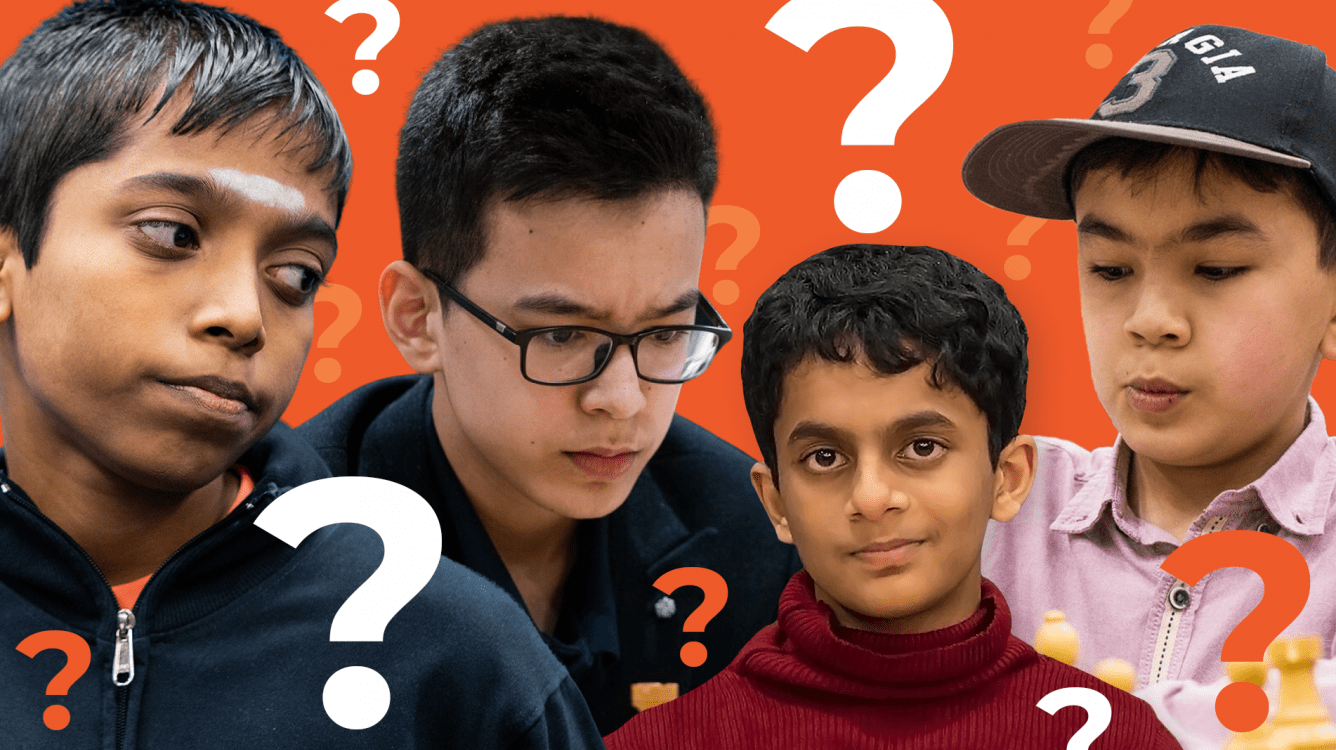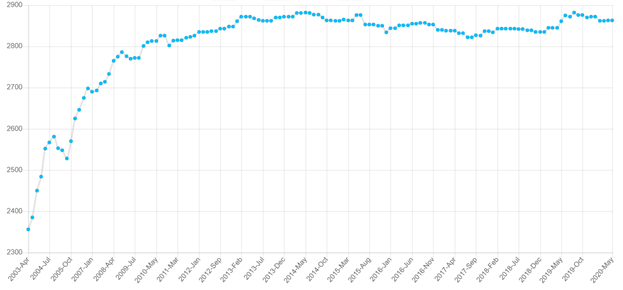
Who Will Be The Next Top Chess Player?
Who will be the next world champion? As we witnessed GM Alireza Firouzja beat GM Magnus Carlsen in a very close match a few weeks ago, we’re starting to consider who will eventually beat Carlsen for the world champion title.
While Firouzja, 2728 as of this month, is a strong candidate to be reckoned with, there are many other strong contenders. Turning 17 later this year, he has already topped the world junior’s rating list and is even ranked 21st on the Top 100 Players list. However, I want to bring special attention to other young players as well.
Reaching 2600 is not an easy feat, and a quick glance at the ratings list tells us just three 2600s are in the under-16 category in the world. However, the question remains, who will become the top player in the world, and not just the juniors list, in five years?
Table 1: The Current Under-16 Rankings for the Top 10.
| # | Name | Fed | Rating | B-Year |
| 1 | Abdusattorov, Nodirbek | 2627 | 2004 | |
| 2 | Nihal Sarin | 2620 | 2004 | |
| 3 | Praggnanandhaa R | 2608 | 2005 | |
| 4 | Gukesh D | 2563 | 2006 | |
| 5 | Keymer, Vincent | 2558 | 2004 | |
| 6 | Sindarov, Javokhir | 2557 | 2005 | |
| 7 | Bjerre, Jonas Buhl | 2549 | 2004 | |
| 8 | Sadhwani, Raunak | 2545 | 2005 | |
| 9 | Suleymanli, Aydin | 2512 | 2005 | |
| 10 | Batsuren, Dambasuren | 2481 | 2004 |
Introducing The Top Three Candidates
We can see that while the highest rated under-16-year-old is 2627, the 10th highest rated is 2481. While 2481 is still a very high and respectable rating, it is not quite 2600. Any of these players is extremely promising, but I want to bring attention to three.
Nodirbek Abdusattorov (Uzbekistan), Nihal Sarin (India), and Rameshbabu Praggnanandhaa (India), who are all above 2600, are names we have seen at top tournaments. By any means, becoming the world champion is not an easy task, and we are not likely to see any of these three players become world champion tomorrow, but if you’re looking to place bets with a friend, I would place my bet on any one of these three.
Three Types Of Progress
Before I dive into a more detailed analysis of each youngster, I want to also point out that while getting a high rating at a young age (Carlsen) may indicate you can possibly become the world champion in the future, it also does not necessarily mean you will reach the distinguished 2800 (GM Teimour Radjabov). Along similar lines, GM Fabiano Caruana started being considered as a potential top player at just age 19 or 20, when he started to beat a lot of the other top players. He was certainly not 2600 at 14 (he was 2444) and, in fact, only reached 2600 when 16 years old.
One such display of skill was in 2012, when Caruana beat GM Sergey Karjakin, who at that time had already been 2700 for years. Being a child prodigy neither means that you will become a world champion in your 20s, nor does it mean that you won't just because you are not 2600 at 14 years old. Of course, I think it is vital to point out that just because you are not 2600 at age 16 does not mean you should be deterred from playing chess and pursuing your goals in the game.
For the sake of conciseness, in this article I will only be looking at the standard Elo ratings.
Introducing The Indian Prodigies
I have chosen to look at Praggnanandhaa and Nihal’s progress together because these two young players spend a lot of time training together. Looking at the progress that Praggnanandhaa, with a rating of 2608 at just 14 currently, tells us a similar trend is experienced by most young players who reach high ratings (2400+): an overall quick rise with the K40 factor, dotted with a few significant rating drops also caused by the K40 factor. The new K40 factor, which was implemented in 2014, simply means that the ratings of all players under the age of 18 with ratings not above 2300 will fluctuate a lot.
Upon reaching 2300 in early 2016, Praggnanandhaa has since had a steady constant rise to 2600. Overall, the line of best fit would make the graph logarithmic, which makes logical sense because young chess players improve rapidly initially, but games become more difficult to win, and opponents become more experienced at higher ratings.
Figure 1: Praggnanandhaa’s Rating Progress Chart.

Figure 2: Nihal’s Rating Progress Chart.

Nihal’s progress chart follows a similar trend, achieving a rating of 2620 in May 2020. Since June 2019, Nihal has gained just 14 rating points in 78 games. While the plateau near the end (after a rather constant but slightly slowing in the rating rise) is in part affected by COVID-19, as tournaments are postponed for the safety of all, not all the plateau can be attributed to the lack of games in recent months. As mentioned, games become more difficult at a higher level, as players become stronger and more comparable to Nihal and Praggnanandhaa.
 Sometimes it is difficult to believe such a young kid is already 2600. Photo: Maria Emelianova/Chess.com.
Sometimes it is difficult to believe such a young kid is already 2600. Photo: Maria Emelianova/Chess.com.
 Nihal hard at work. Photo: Maria Emelianova/Chess.com.
Nihal hard at work. Photo: Maria Emelianova/Chess.com.
They also likely have better resources such as coaches and seconds compared to the opponents the young players have faced before, and players need to pay more attention to minute details of the game. While I have no doubt that Nihal and Praggnanandhaa are already seasoned players, most of the opponents in the tournaments they’re playing in will have quite a few more years of experience and knowledge.
The Highest Rated Under-16-Year-Old
Abdusattorov, who is very slightly ahead of Nihal and Praggnanandhaa at 2627, has a rating progress chart that is slightly different. I had played Abdusattorov about a year before his dramatic rating rise, which means I can say I contributed a bit to his 2600 rating! At only 10 years old he was already quite a strong player and quite a few years younger than I was.
In context, in 2014 I was 14 and had a rating of 2157, while my opponent had a rating of 2186. Did I predict his meteoric rise to 2600? Quite honestly, not at all, but I am glad to see he has been successful so far in his young career.
Figure 3. Abdusattorov’s Rating Progress Chart.

While we can see both Nihal and Praggnanandhaa have had quite significant rating increases in any month, Abdusattorov gained 201.6 points in April 2015 with the help of K40, pushing him above 2400 (and quite significantly as well). Since then, he dipped below 2400 briefly between February and October 2016. However, after a brief spell in the 2300s, his rating since then has been increasing steadily with minor rating losses.
 The young Abdusattorov deep in thought. Photo: Maria Emelianova/Chess.com.
The young Abdusattorov deep in thought. Photo: Maria Emelianova/Chess.com.
Because Praggnanandhaa, Nihal and Abdusattorov are already at 2600, the next question to ask is whether they will reach 2700. In my opinion, they will, and it’s only a matter of time. I know Praggnanandhaa and Nihal (whom I almost met at training camps in Europe) have the talent and resources necessary. Of course, this doesn’t leave out Abdusattorov’s contention for the world title in a few years, but I am less familiar with his training.
Other Potential World Champions
Aside from the clear favorites for the world championship title in a few years, I do believe there are many other strong contenders in future years. Dommaraju Gukesh (India), at almost 14 years old, is the second-youngest person to qualify for grandmaster. At 2563, he is perfectly well on track to become 2600 before his 15th birthday and aim for 2700. Similarly, Javokhir Sindarov (Uzbekistan), who is currently 15, is a grandmaster at 2557. Another strong Indian talent, GM Raunak Sadhwani is 2545 at 14.
All three players have rating progress charts like either Praggnanandhaa's and Nihal’s or Abdusattorov's.
Figure 4: Dommaraju Gukesh’s Rating Progress Chart.

We can see the plateau near the end that was discussed earlier.
Figure 5: Javokhir Sindarov’s Rating Progress Chart.

Sindarov’s progress chart is more similar to Abdusattorov’s chart. It shows Sindarov has also experienced significant rating increases and decreases.
Figure 6: Raunak Sadhwani’s Rating Progress Chart.

Sadhwani’s progress chart is very much like Praggnanandhaa’s chart. Overall we can predict that all three players will experience rating increases.
Child Prodigy Everyone Knows About
Next I want to compare these top young players to the world champion and his last challenger.
Figure 7: Magnus Carlsen’s Rating Progress Chart.

Carlsen turned 15 in November 2005. Since 15 is roughly the average age of Praggnanandhaa, Nihal, and Abdusattorov, a lot of insight can be gathered from comparing their progress charts. At 15, Carlsen had just gone above 2600 in January 2006, and by October 2006 at age 16 was 2698, almost 2700. While, of course, Carlsen is the current world champion and is quite possibly the strongest player in history, in terms of milestones, I would say that the current three youngsters are very much on track to accomplish something similar.
A Tale of Gradual Progress
We can see that for both Carlsen and Fabiano, the year or two after reaching 2600 is crucial, as both charts show rating increases. While Carlsen’s was more explosive, Fabiano steadily climbed to 2700 within two years after reaching 2620 in April 2008, when he was 16.
Figure 8: Caruana Fabiano’s Rating Progress Chart.

As I mentioned, we don't see Fabiano rise to fame (2800) immediately, but we see a rather gradual increase starting from 2012.
Using the five main players we have discussed so far, Praggnanandhaa, Nihal, and Abdusattorov for the upcoming candidates as world champions and Caruana and Carlsen as the current top two, we can predict what rating patterns we need to see for the three young players.
Figure 9. Rating vs. Age Projection.

In this analysis, I have assumed a logarithmic line of best fit, comparing it with each line’s corresponding R2 value. While we predict that Praggnanandhaa, Nihal, and Abdusattorov will reach high ratings, they are not all you need to become the world champion. One can be extremely highly rated but not become a world champion. Also, the analysis is not taking into consideration potential human outliers, such as any player not continuing chess after a certain age, or other possible disturbances to the trend.
Keeping a close eye on Praggnanandhaa, Nihal and Abdusattorov will be important in the upcoming few months as tournaments start up again. Not being able to play chess for a few months is quite challenging for young players who are more used to playing tournaments every month, and I believe we are all excited to see what happens not only with their ratings after lockdowns lift globally, but also what changes in their chess skills we might see.




